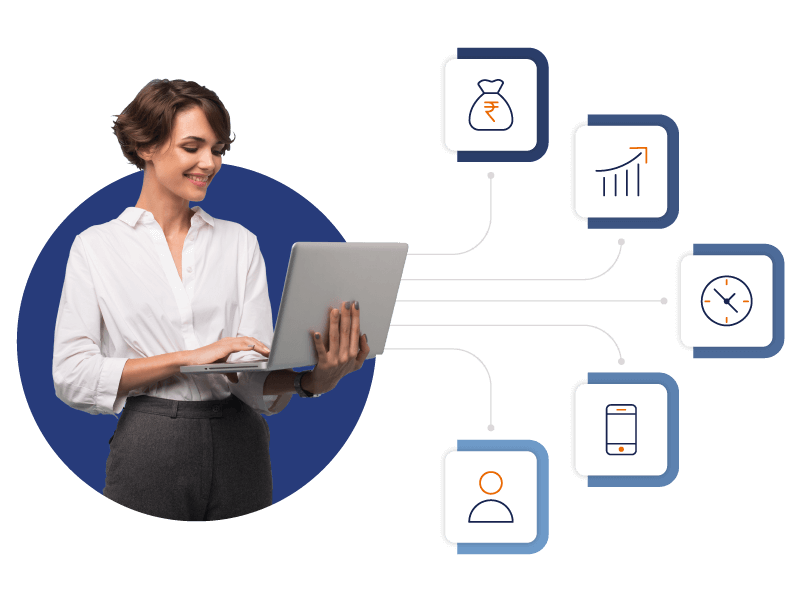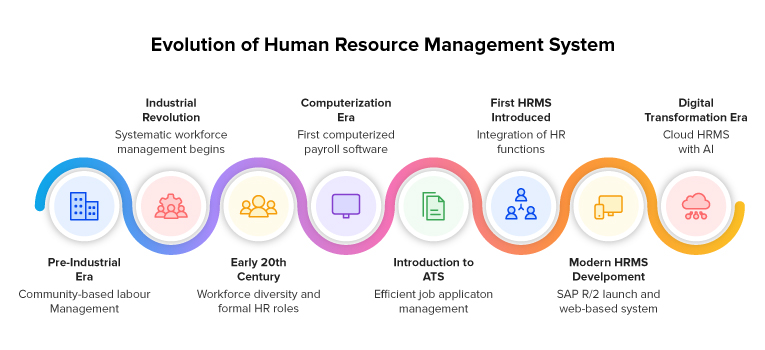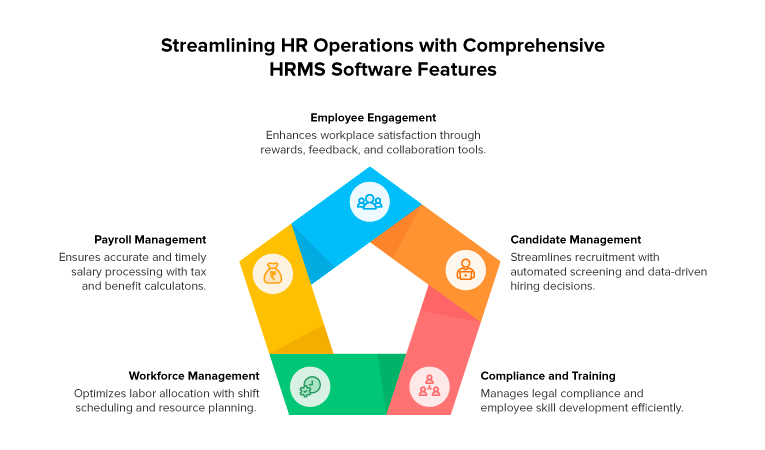What is HRMS – A Comprehensive Guide 2025

Download HRMS Guide for Free
Table of Contents
A quiet revolution in the name of HRMS occurs amongst successful organizations worldwide in today’s competitive market. Organizations employing Human Resource Management Systems (HRMS) have a competitive advantage over others. At its core, HRMS is the backbone of an organization’s human resources function.
It spans the entire employee lifecycle from recruitment and induction to performance measurement, compensation, and career growth. This article emphasizes significant HRMS characteristics, advantages, and stakeholders interacting with it.
What is HRMS?
“HRMS” stands for Human Resources Management System. It refers to a suite of software applications that help you manage core HR tasks. These include everything from hiring candidates to calculating their payments and streamlining operations.
It automates key human resource operations and improves productivity. HRMS software offers data-driven decision-making for your organization by providing insights into employee performance, preferences, and productivity. It helps centralize and digitize processes such as employee data storage, administration, and time and attendance tracking.
For instance, each department has massive employee information, such as marketing, production, sales, inventory, and packaging. As a human resource manager, you need to capture, store, and process this information from several places. The software helps centralize the information.
But how come a single software helps you automate several tasks and transform HRM?
History of Human Resource Management Systems (HRMS)
Human Resource Management Systems (HRMS) have evolved from informal labour management in the pre-industrial era to the rise of computerised payroll calculation mechanisms.

Here is the complete history of how HRMS evolved.
- Pre-Industrial Era- Labor management was focused on a community-based approach.
- Industrial Revolution- Due to mass production, systematic workforce management began. New welfare roles were also introduced to protect workers.
- Early 20th Century- Increased workforce diversity with women joining industries led to formal roles for recruitment, dismissal, and employee relations.
- Computerization Era- The first computerized payroll system to automate clerical tasks.
- Introduction of Applicant Tracking Systems (ATS)- Development of systems to manage job applications more efficiently.
- First HRMS Introduced- Integration of various HR functions into cohesive systems was first introduced in the 1980s.
- Modern HRMS Development- SAP R/2 launch integrates HR with other business functions. Plus, there was a transition to web-based systems for broader access and employee self-service functionalities.
- Digital Transformation Era- Switching to cloud HRMS with AI cuts costs and implementation time by removing on-premises infrastructure. AI improves recruitment, engagement, and analytics.
Why the HRMS System is Important
HRMS systems become essential for your HRM, especially in improving the accuracy of task execution. For example, if you are using HRMS to understand the working hours needed to complete specific tasks, you will get complete insights into the reasons for delays. Not just the productivity, but HRMS systems help you with,
Reduced HR Costs
When you install an HRMS system, you will experience reductions in your operational costs. Manual paperwork and unnecessary administrative activities can increase your budget. With an HRMS, you automate them so your HR staff can do more with less.
Rapid HR Innovation
Embracing the best Core HR platform provides a platform for ongoing HR improvement and innovation. With mundane tasks automated through workflows, your HR department can reallocate its energies towards creating pragmatic HR strategies. The analytics power of today’s Core HR solutions offers data-driven insights that fuel innovation in hiring, retention, and people development.
Engaged Employees
The most valuable contribution of a human resources management system is improved employee engagement. It is crucial because 54% of employees are likely to remain in an organization if they experience a positive employee experience. This is where a self-service portal comes into play. Your self-service portals enable employees to update their information, access company resources, and resolve routine requests without delays.
What are the Key HRMS Software Features?
Here are some key HRMS features you need to automate and optimise HR operations.

Candidate Management
With an HRMS solution, you can track and screen applicants effectively through automated screening, CV parsing, and interview scheduling. Your recruitment team can access candidate profiles from a central database, enabling you to make faster, data-driven hiring decisions.
Employee Engagement
HRMS applications for rewards, feedback, and team collaboration can enhance workplace satisfaction. Various survey methods can also help you collect information and understand what employees think about your engagement activities.
Employee Management
HR management software enables you to manage your entire workforce within a single platform. HRMS provides enhanced visibility over your HR operations through employee profiles, organizational charts, and team hierarchies.
Payroll Management
HRMS accurately processes salary payment, tax deduction, and benefit payroll. The payroll is processed quickly and with fewer discrepancies, providing accurate, timely remuneration for your employees.
Workforce Management
With the appropriate human resources management system, you can fine-tune your labor allocation through shift scheduling, workload allocation, and resource planning features. Your managers can see real-time information to make staffing decisions per your business needs.
Recruitment Management
With HR software you can streamline your entire hiring process from job posting to generating offer letters. It provides customizable recruitment workflows that help you attract, evaluate, and onboard top talent efficiently.
Manages Leave and Attendance
An HR management system automatically tracks employee leave requests, attendance trends, and recorded working hours. Employees can submit their leave requests online, ensuring you maintain precise attendance records for payroll processing.
Onboarding
An HRMS system allows you to ensure a seamless onboarding experience for new employees by automating paperwork, training schedules, and welcome workflows. This structured onboarding process improves productivity and boosts retention.
Employee Information Management
You maintain your comprehensive employee database with secure, centralized record-keeping. Your HR team and employees access and update personal information through role-based permissions.
Salary Changes and Increment Calculations
You can systematically process your pay revisions, promotions, and annual increments using HRMS payroll features. Your automated calculations ensure accuracy in salary adjustments while maintaining proper approval workflows.
Offboarding Process
Human resource management system helps you manage employee exits by creating standardized checklists, implementing knowledge transfer protocols, and managing exit interviews. Your systematic approach recovers company assets and preserves organizational knowledge.
Statutory Compliance
The right HRMS software efficiently manages compliance with local labor laws, tax regulations, and reporting requirements. Your automated compliance tools reduce your legal risks and administrative burden.
Training and Development
With a reliable HRMS platform, you can monitor your employees’ certifications, learning routes, and skill development. A combined LMS and HRMS system handles course registration, training, and competency measurement.
Performance Appraisal
You can implement structured evaluation cycles using HRMS systems with customizable review forms, goal tracking, and feedback mechanisms. The performance data of your employees aids in determining important promotions within the organization.
Benefits of Using a Human Resource Management System
Here are some key benefits to expect from a human resources management system,
Data Management
Secure data storage in a centralised human resources management system gives you total management over your employee data. Your HR department can access real-time updates immediately and create customized reports. It also helps secure sensitive organizational data.
Employee Self-Service
With intuitive HRMS portals, you can empower your employees to self-manage their information. Your employees can update personal details directly, download pay slips, request leave, and view company policies without loading your HR team. Your self-service tools eliminate administrative queries, leaving your HR professionals free for strategic work.
Better Workforce Planning Decisions
You make well-informed decisions with in-depth analytics from an hr management system software. Your personalized dashboards emphasize workforce trends, skills gaps, and succession planning possibilities. With an HRMS, you streamline team structures and resource allocation to address your evolving business requirements.
Better Recruitment
With HR management software, you can revolutionize your recruitment process. AI-based HRMS solutions allow you to discover the finest talents faster, while your systematic interview processes ensure consistent evaluation. It can help you reduce your time-to-hire and improve the quality of your candidates.
Better Employee Retention
With predictive analytics and employee sentiment monitoring in hr management system software, you can spot attrition risks before losing valuable team members. This assists in aligning development programs and showing your dedication to employee development. By actively managing the key components of employee retention, you can substantially lower turnover expenses and retain institutional knowledge.
Who Uses HRMS Software?
Here are some of the major stakeholders that use HRMS software.
HR Professionals
As an HR professional, you can use HRMS to reduce manual tasks and improve focus on strategic policies. Your administrative load reduces significantly as you automate repetitive tasks such as leave approvals and data entry. You obtain valuable insights through in-depth reports and analytics, enabling you to guide your management on important workforce decisions.
Department Managers
As a department manager, you can access employee information and manage your team efficiently without endless HR intervention using HRMS. This information can include performance monitoring, employee attendance, and task schedules. You can make informed decisions regarding resource allocation and employee development using real-time information.
Employees
Using self-service portals can improve the employee work experience. Employees can easily request leaves, change details, and view benefit information. They can also connect more closely with your company through immediate access to training options and performance guidance.
How do You Find the Right HRMS?
When selecting your HRMS system, consider solutions addressing your organizational needs. Determine how the system will cure your current pain points while supporting your future expansion plans.
1. Scalability
You need a system that grows alongside your business without requiring replacement. Your ideal HRMS solution accommodates increasing employee numbers, additional locations, and expanding functionality. Check if you can activate new modules without disruptive implementations or costly upgrades.
2. Check Key Features
You must ensure the system provides comprehensive functionality for your core HR processes. Your priority areas include recruitment, onboarding, performance management, and payroll integration. Evaluate how these features align with your unique workflows rather than accepting generic processes.
3. Check Security and Compliance
Data protection and regulatory adherence must not be compromised. Your HRMS should offer role-based access controls, data encryption, and audit trails. Verify that the system automatically updates to comply with local labor laws and data protection regulations.
4. User Experience
Your ideal system provides intuitive navigation, mobile accessibility, and customizable dashboards. Request trial access for various user roles to confirm that the system feels welcoming and straightforward for your team.
5. Compare Pricing and ROI
You need transparent costs that deliver clear value. Look beyond the initial price to understand your implementation fees, ongoing support costs, and additional user or module charges. Calculate your expected ROI based on time savings, error reduction, and strategic advantages.
6. Check for Customer Reviews
You benefit from learning about others’ experiences. Research feedback from organizations similar to yours regarding implementation challenges, support quality, and system reliability. Contact existing customers directly to gain unfiltered insights about their experience when possible.
Choosing factoHR as your HRMS software can help transform your HR function from an administrative burden to a strategic advantage. Your HR team reclaims valuable hours while your employees enjoy seamless self-service experiences.
With factoHR’s comprehensive analytics, you make confident workforce decisions backed by real-time insights, not hunches. Join the thousands of companies that have revolutionized their people management with factoHR – where your HR challenges meet their solution.
Future of Human Resources Management System
The HR management systems you implement today will transform into an advanced workforce. Future HR technology will use AI for predictive analytics, helping identify flight risks and suggesting personalized development paths. Expect better integration between HR systems and other business applications, creating a unified experience.
As remote and hybrid work becomes standard, your HRMS will feature enhanced collaboration and virtual onboarding to maintain organizational culture across dispersed teams. Investing in adaptable, future-ready HRMS tools will position your organization to attract and retain top talent in a competitive market.
What does HRMS Stand for?
HRMS stands for Human Resource Management System. It’s a software solution designed to streamline and automate HR processes, enabling organizations to efficiently manage their workforce while ensuring compliance with regulations and standards.
What are the Common Functions of HRMS Systems?
Standard HRMS functions include employee data management, payroll processing, benefits administration, and time and attendance tracking. These functions create a centralized system that handles the complete employee lifecycle from hiring to retirement.
What’s the Difference between an HRMS, HRIS, and HCM?
HRMS typically offers comprehensive HR functionality, including payroll and benefits. HRIS (Human Resource Information System) generally focuses on storing and organizing employee data. HCM (Human Capital Management) is broader, encompassing HRMS capabilities plus strategic elements like talent management, workforce planning, and analytics to optimize human capital as a business asset.
What are the Emerging Trends in HRMS?
Emerging HRMS trends include AI-powered analytics, mobile accessibility for on-the-go HR management, employee self-service portals, and specialized remote/hybrid workforce management solutions.
Grow your business with factoHR today
Focus on the significant decision-making tasks, transfer all your common repetitive HR tasks to factoHR and see the things falling into their place.

© 2025 Copyright factoHR


